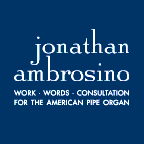Book: *****
Splendid Service: The Restoration of David Tannenberg’s Organ for Home Moravian Church; 116 pages; 50 illustrations; published 2004, Old Salem, Inc.
http://store.yahoo.com/oldsalemonline/spsereofdata.html (from OHS Catalog)
http://store.yahoo.com/ohscatalog/spsereoftaor.html (from Old Salem Online store)
CD Recording: ****
Salem’s Large Tannenberg Organ Restored
Krebs, C.P.E. Bach, Latrobe, Mozart, Mendelssohn, Locklair
Raven Recordings OAR-700; Peter Sykes, organist
http://store.yahoo.com/ohscatalog/salatare.html
Precious few organs were built 200 years ago in America; fewer still survive to the present day. In this context, the restored 1800 Tannenberg at Old Salem is one of America’s most important instruments. David Tannenberg, a Saxon native, came to Pennsylvania seeking to further his carpenter’s vocation. Eventually he became an organbuilder’s assistant, assuming the mantle of his master, Johann Gottfried Klemm, upon the latter’s death in 1762.
Tannenberg’s work is a mixture of excellence and insularity. His sole influences were Klemm’s example and a German organ-building treatise. The Tannenberg style echoes the gentle, quasi-orchestral approach prevalent in the central German regions of the early 18th century — a thread possibly overshadowed by Silbermann and his successors. With current American scholarship re-discovering the 18th-century German organ in all its permutations and implications upon the music of J.S. Bach, the Tannenberg’s restoration is a particular bit of handsome timing.
The instrument in question was completed in 1800 for Home Moravian Church in Salem, North Carolina. It was removed to storage in 1910 — miraculous, since in that time most old organs were simply discarded — and was eventually strewn about the village like second-hand clothes. In 1989 it was decided to restore the instrument, and after much fundraising, research, documentation, detective work, restoration and finally reassembly, the organ was completed in early 2004. Publicly visible as part of a visitors’ center, the instrument resides in a new auditorium with fine acoustics.
The project’s completion was celebrated with a symposium and rededication recital last March. Two handsome productions resulted: a recording of the dedication recital repertoire by Peter Sykes on the Raven label, and a softbound monograph Splendid Service, produced by Old Salem, Inc., the non-profit organisation handling tourism, scholarship and archival activities of this old Moravian settlement.
The recording gives a helpfully accurate representation of the organ’s effect in the auditorium. Sykes’ affinity for old American organs approaches alchemy, and he is a master at bypassing preconception to reveal the essence of the instrument at hand. In this case, the key feature is slow voicing: flutes that coo like doves, strings almost impossibly languid in their development, and principals that take their sweet time in developing a shiny whang. There’s a small crescendo as the chords settle in, and Sykes knows how to handle what others might find an obstacle. For him, the voicing, wind and action are clearly a trio, and he ‘leans in’ with knowing suppleness. Occasionally one wishes for greater variety in registration: the repeat of the Mozart, for example, is just that. But these are minor quibbles; gracious playing and a fascinating instrument make this disc much more than a document.
Splendid Service comes in at just over a hundred pages, concentrating on three well-crafted essays. William Armstrong, who has written a biography of Tannenberg, covers the builder’s life and work. Paula Locklair, curator at Old Salem and wife of the composer Dan Locklair, turns in an elegant piece on Moravian music-making and the liturgical practices at Home Moravian. And Bruce Shull of Taylor & Boody Organbuilders, restorers of the instrument, discusses the project in considerable detail, culminating in technical data on the various ranks. The three essays are edited such that no ground is doubly covered, and each amplifies the others. With its good photography and solid production values, Splendid Service sets a splendid example for the American monograph. Dozens of American instruments warrant such comprehensive, well-reasoned and attractive treatment. |
